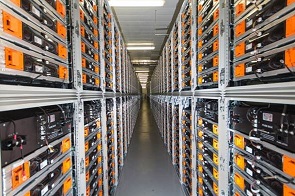WASHINGTON, July 7, 2015 - Calling Tesla not just a car company but an “energy innovation company,” Tesla’s founder Elon Musk unveiled his cost-cutting Powerwall and Powerpack battery systems earlier this year, designed to “move the electricity grid off of fossil fuels and towards renewable energy sources.”
While critics, including many utility companies, argue that renewables will never become reliable enough or cheap enough to replace coal and natural gas for generating electricity, Musk disagrees.
“Once we’re able to rely on renewable energy sources for our power consumption, the top 50 percent of the dirtiest power generation resources could retire early,” he said at the unveiling. “We would have a cleaner, smaller, and more resilient energy grid.” He says Tesla’s higher-power, lower-cost lithium ion rechargeable batteries give homes, businesses and utilities the ability to “store sustainable and renewable energy to manage power demand, provide backup power and increase grid resilience.”
For electric utility companies, Tesla’s battery systems provide up to four hours of continuous net discharge power. They offer on-demand distributed power generation, a buffer when power output from a large generation source is ramping up or down, instant power for blackouts or to transition output smoothly, improved power quality, avoidance of infrastructure upgrade costs, peak demand management, and support for self-sufficient micro-grids. Tesla’s partners in developing storage include Southern California Edison and SolarCity, which forecasts that “every SolarCity customer will get a battery backup for their solar systems within five to 10 years.”Bottom-line benefits for utilities include reducing or eliminating the need to purchase high-cost power during peak demand periods. At utility scale, when Southern California Edison installed a battery in Orange, California, grid reliability improved and infrastructure investments were postponed. Small-scale beneficiaries include moviegoers in California, thanks to Southern California Edison installing Tesla batteries at two Cinemark Theaters.
Recent storage breakthroughs are also attracting attention on Capitol Hill.In Senate Energy Committee hearings in June, Chairman Lisa Murkowski, R-Alaska, Sen. Al Franken, D-Minn., and Department of Energy Under Secretary Lynn Orr agreed on the importance of energy storage.
Murkowski called energy storage “exciting.” Franken said developing new systems to store electricity “will allow us to incorporate more renewables, it will give utility customers more control over their energy use, and will help them keep the lights on in case of a grid outage.”
Pointing to storage research at Argonne National Laboratory and other DOE labs, Orr said DOE’s breakthrough work on electro-chemistry and nano structures goes “beyond lithium ions” to develop batteries with greater energy density, greater power delivery and lower weight. The results, he said, will benefit “the cell phone right up to the grid, on a variety of time scales from the short-term variations of a wind turbine, to the day/night variations, or even to the winter/summer kinds of variations.”
Other witnesses joined Orr in explaining that energy storage will become increasingly important as intermittent energy sources like wind and solar continue to increase their share of the U.S. energy supply. Bipartisan Policy Center board member Norman Augustine testified that “Few other technologies could be as much of a game-changer for the U.S. energy system and international technology leadership.”
Still, the costs of many current storage systems will have to come down to be more economically attractive. A recent NREL report, “Grid Integration and the Carrying Capacity of the U.S. Grid to Incorporate Variable Renewable Energy,” notes that “many available storage technologies have a higher capital cost relative to other options for flexibility currently available. In most power systems, further technology improvements will be needed for storage to be cost competitive with other flexibility options.”
Little wonder, then, that some businesses would like to see the federal government do more to invest in new energy storage breakthroughs.
Karen Harbert, president and CEO of the U.S. Chamber of Commerce’s Institute for 21st Century Energy, endorsed storage legislation proposed by Franken, S. 1256, The Advancing Grid Storage Act. Harbert said that without a functional and cost-effective stationary storage component widely deployed throughout the distribution grid, “renewable power will never be baseload, limiting its potential use.” She said Franken’s bill “takes a step that DOE has not, making development of stationary storage a research priority and establishing a framework where commercialization is possible.”
Franken’s bill would provide $50 million for DOE to supercharge its energy storage research and provide loans, grants and technical assistance aimed at improving the nation’s electricity system. This would be accomplished through steps including “facilitating the use of renewable energy resources” and “strengthening the reliability and resiliency of energy infrastructure to the impact of extreme weather events, power grid failures, and interruptions in supply of fossil fuels.”
Another bill that could become part of comprehensive energy legislation this year is S.143, the Energy Storage and Deployment Act, introduced by Sen. Martin Heinrich, D-N.M. The bill would require utility companies to install enough storage to meet at least 1 percent of peak power demand by 2020 and 2 percent by 2024. Storage devices could be “pumped hydropower, compressed air, batteries or other electrochemical forms (including hydrogen for fuel cells), thermal forms (including hot water and ice), flywheels, capacitors, superconducting magnets, and other energy storage devices.”
#30
For more news, go to: www.Agri-Pulse.com

